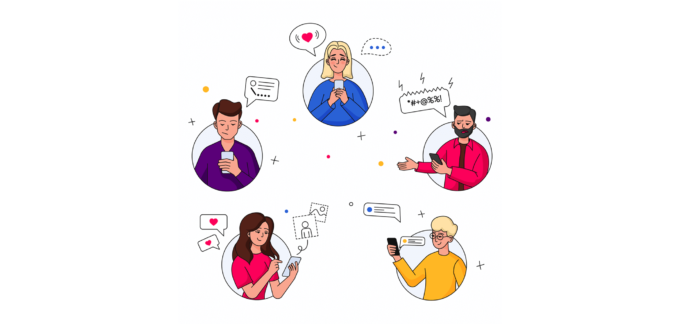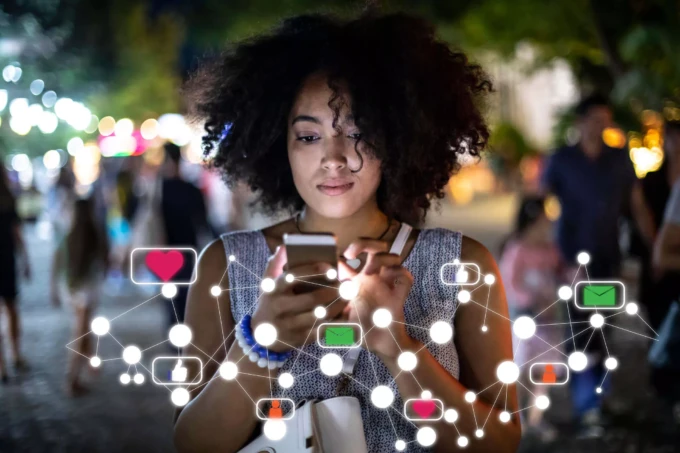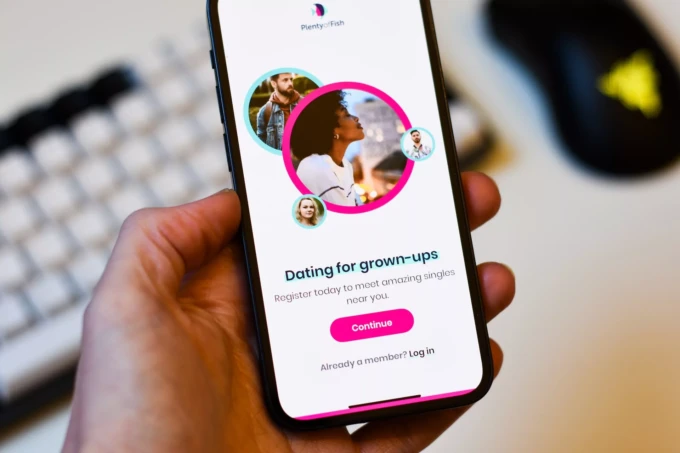Contents
We surveyed 2,000 dating app users across the United States, asking: “What is your experience with dating apps and the chats in particular?”
The stats from surveying dating app users proved a lot of hypothesis, especially about how women experience chats.
First, when asking users about dating apps, we were only interested in users who have used a dating app post-pandemic. Adapting to dating apps and websites has been advantageous for many people, providing them an excellent opportunity to find love.
However, reports about plummeting stocks and real issues with user growth beg the question of why people are abandoning these apps. And if people are asked to pay for an account, shouldn’t they have the right to a good user experience? Seems like that’s not a lot to ask.
We asked 2,000 US dating app users aged 18-75 how their experience with apps and the in-app chats/messaging affected their willingness to stick around on the app.
We were interested in learning more about trust and safety on these platforms as it pertains to their end users. How common are fraud, catfishing, and fake accounts, and how many men and women are affected?
We have worked with content moderation for various platforms over the years, so it’s a subject near and dear to our hearts.
Interesting stats from Besedo’s survey
We could argue that users of dating apps have come to expect particular behavior from other users. There is almost a normalization of bad experiences because, despite the many cases of fraud, harassment, unwanted content, etc., few people claim they had an overall bad experience.
68.4% of all users have come across fake profiles on dating apps.
- 18.7% consider their overall in-app messaging experience to be negative.
- 72.2% of all users have experienced fraud (e.g., false information, fake profiles, catfishing, monetary theft)
- 72.8% of all users have experienced harassment (e.g., unwanted messages, inappropriate content, threats)
- 78.6% of all women have at some point experienced harassment.
There is much more to it than just a few handpicked data points, so read on for plenty of observations based on the data we collected.
America’s favorite dating app
We asked 2,000 men and women who use dating apps what apps they are using. Many use multiple apps and we have also arranged the apps in order of popularity by US State as well as the overall most used apps.
We asked “Which apps are you using?” Answers is calculated by dividing each answer count by the total counts collected.
Most used dating apps among American users:
- Tinder 16%
- Bumble 12.8%
- eHarmony 9.5%
- Facebook Dating 12.3%
- Plenty of Fish 9.2%
- Hinge 6.82%
- Match 6.78%
- OkCupid 5.4%
- Grindr 3.6%
- Badoo 3%
- BLK Dating 2.9%
- Coffee Meets Bagel 2.5%
- Zoosk 2.4%
- Boo 1.1%
- Her 1.1%
Some honorable mention to Hily, SweetMeet, Feeld, and Happn.
Top-5 used dating apps by state
So now you can check if you are using the right apps to find love in your state 👍
Chats: Not great
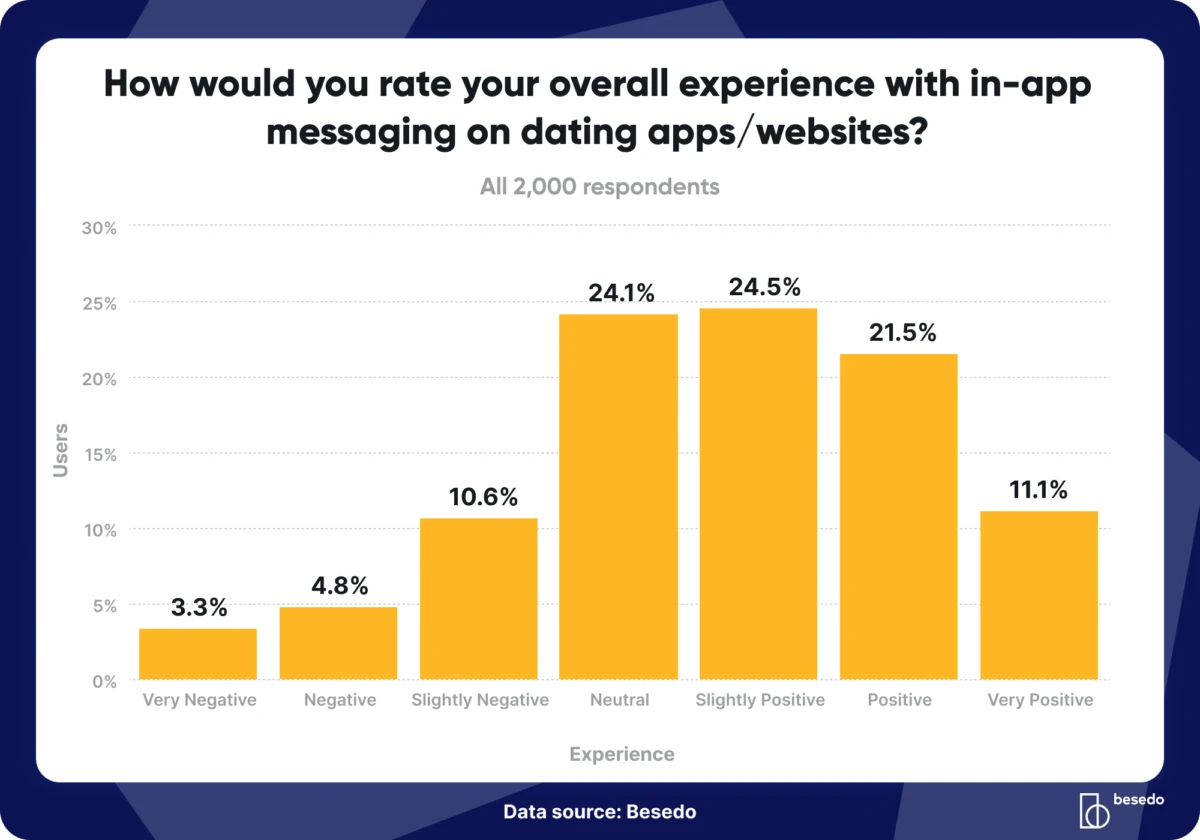
Most users lean towards a neutral to slightly positive experience, and 18.7% reported a negative experience.
Are users just tolerating a bad experience?
At first glance, the survey results suggest that most people don’t find dating app chats outright terrible. But what if the real issue is lowered expectations?
Many users might not label their experience as “bad” because they’ve simply gotten used to bad behavior.
- Desensitization: Unwanted messages, ghosting, and scams are so common that they no longer feel shocking.
- Lowered expectations: If a conversation is just “fine” (meaning no harassment or scams), users might rate it as neutral or slightly positive, even if it wasn’t particularly enjoyable.
- Coping mechanisms: Many long-time users have learned how to navigate bad experiences by blocking, unmatching, or simply ignoring unwanted messages.
Takeaway: If people expect a poor experience, they may not even recognize how much better it could be. Dating apps might need to rethink how they improve messaging culture, not just remove the worst offenders.
Harassment and fraud: A recurring problem
While dating apps open doors to new connections, they expose users to unwanted behavior, from inappropriate messages to full-on scams. But how big is the problem? We asked users how often they’ve encountered harassment and fraud using in-app messaging.
Harassment in dating app chats
- 72.8% of all users reported experiencing some level of harassment.
- 42.4% of all users said they encounter harassment sometimes, usually, or always.
Unwanted messages and inappropriate content are the most common types of harassment.
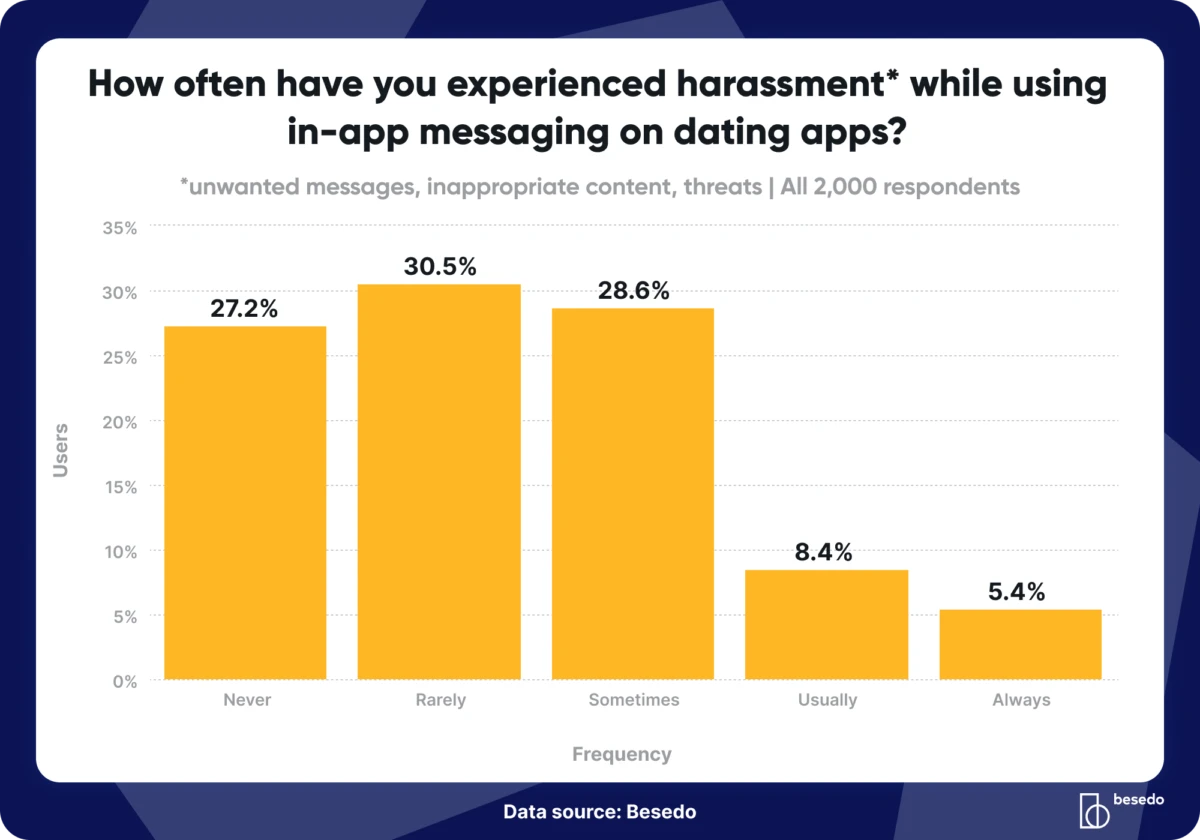
That is 7 out of 10 users that at some point experience some form of harassment in chats on dating apps. Not a great number.
The gender divide: Who gets harassed more?
It’s not a surprise, but not all users have the same experience regarding in-app messaging. Harassment and fraud affect everyone, but they don’t affect everyone equally.
When we break down harassment by gender:
- 78.6% of women reported experiencing some level of harassment.
- 66.7% of men reported the same.
- Women is significantly likely to experience harassment and more likely to report experiencing severe harassment (usually or always).
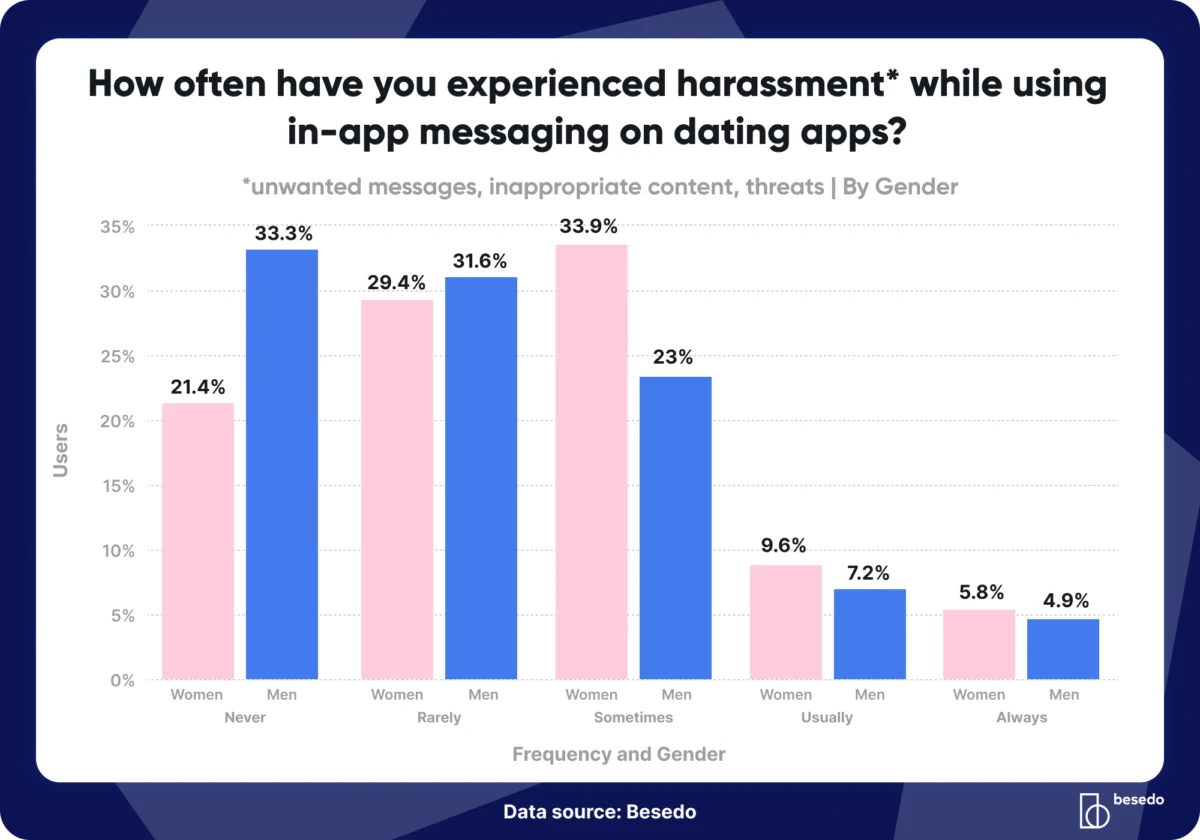
Fraud: A more even playing field?
Unlike harassment, fraud affects men and women more equally:
- 70.1% of women encountered fraud in dating app chats.
- 74.4% of men experienced fraud.
- However, the types of fraud differ. Women report catfishing and romance scams more often. At the same time, men are more likely to encounter financial scams or fake profiles pushing external links.
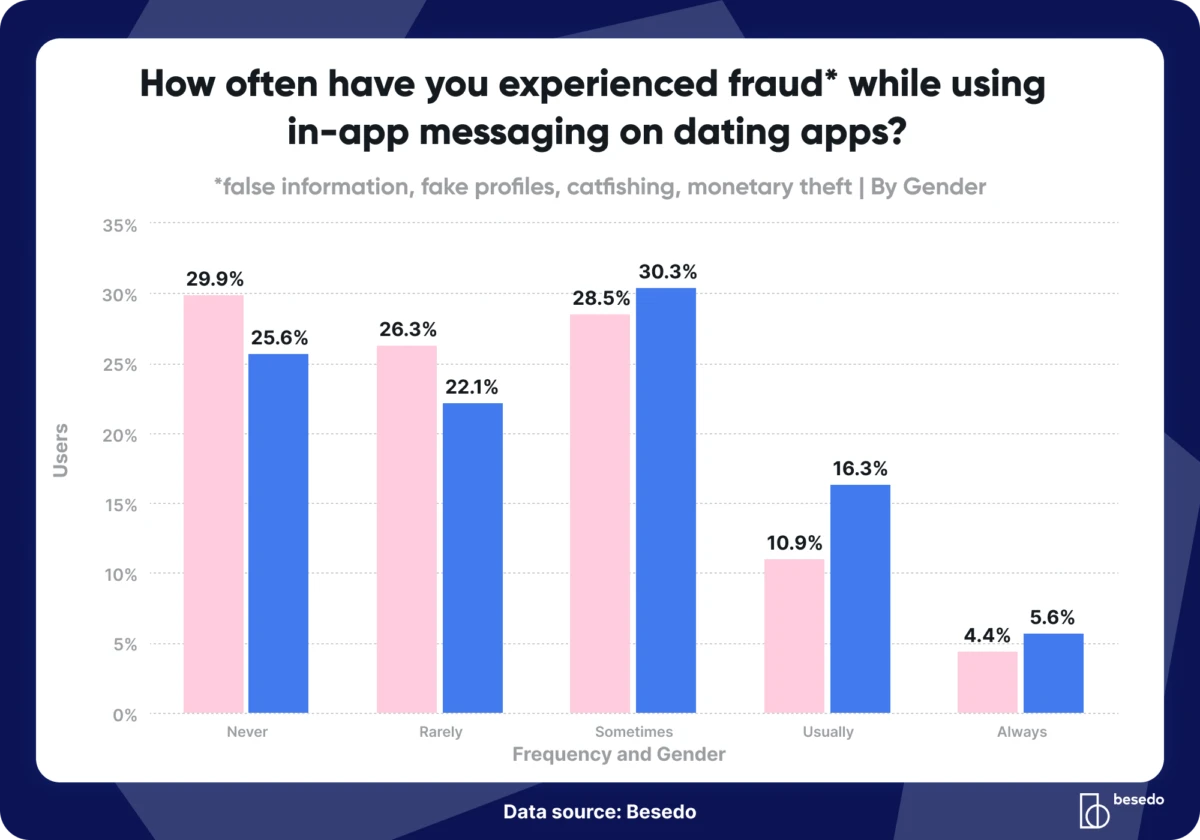
That means that more than 2 of 10 men say that they are usually experiencing fraud in chats. Not great numbers either when you are trying to build trust between users.
Why are women more likely to report harassment?
A note on reporting harassments: While dating app fraud is more balanced across genders, harassment remains a much bigger issue for women. But why? Women don’t just experience more harassment; they are also more likely to recognize and report it.
- Cultural expectations: Many women enter online dating expecting some form of unwanted attention, which means they might be more aware when it happens.
- Different thresholds for discomfort: What one user might see as a “harmless” flirty message, another might see as invasive or inappropriate.
- Men might underreport harassment: Some men may also face harassment but don’t recognize or label it as such, leading to an underestimation of the issue.
Bad experiences drive users away
Bad in-app messaging experiences aren’t just frustrating—they’re making people rethink whether dating apps are worth their time (or money).
66.1% of users say they use a dating app less frequently due to bad experiences.
49.7% have stopped using a dating app entirely because of bad experiences.
However, a majority of those who quit didn’t immediately delete their accounts. They just stopped engaging.
This trend, known as soft churn, is a major issue for dating apps. Many frustrated users don’t formally delete their accounts. Instead, they gradually disengage. They might still appear in match pools but aren’t actively swiping or messaging. This creates a misleading impression of user activity while quietly weakening the platform.
For dating apps, soft churn has a cascading effect:
- Fewer engaged users mean worse match quality.
- More ghosting leads to frustration among active users.
- Fewer paid subscriptions result in declining revenue.
Dating apps depend on subscriptions and premium features, but if free users are dissatisfied, convincing them to pay for an upgrade is a tough sell. Many former subscribers who stopped using the app also let their premium memberships lapse.
The problem isn’t just user acquisition. It’s engagement. New users join, but they don’t stick around. Soft churn makes platforms appear more active than they are, and negative experiences prevent free users from converting into paying customers. If dating apps don’t improve the user experience, they risk losing engagement and revenue.
Final thoughts
You’re not alone if dating apps feel like they’ve lost their spark. Our survey found that many users are frustrated with in-app messaging, and a significant number are either using the apps less or quitting altogether.
When ghosting, harassment, and fake profiles are part of the daily experience, it’s hard to stay excited about swiping.
This isn’t just something we noticed— the entire dating app industry is feeling it too. The Financial Times highlighted how Match Group, the company behind Tinder, Hinge, and OkCupid, has seen its market value drop from $40 billion to $8 billion in just a few years. Fewer people are paying for premium memberships, and some are stepping away from dating apps entirely in favor of real-life interactions or smaller, more community-driven platforms.
At the same time, dating apps are experimenting with AI-driven matchmaking and new safety features, but skepticism remains. Can AI really fix what’s broken in online dating? Maybe. But at the core of all this is a simple truth. People want meaningful connections and don’t want to feel like they must sift through frustrating experiences just to get there.
Dating apps aren’t going away, but they need to evolve. The challenge is whether they can improve the experience or if users will continue disengaging until something better comes along.
Ahem… tap, tap… is this thing on? 🎙️
We’re Besedo and we provide content moderation tools and services to companies all over the world. Often behind the scenes.
Want to learn more? Check out our homepage and use cases.
And above all, don’t hesitate to contact us if you have questions or want a demo.
